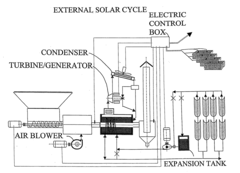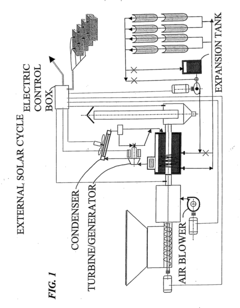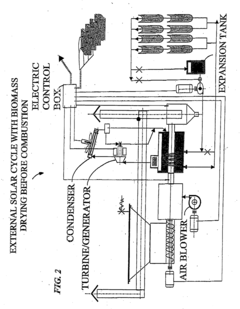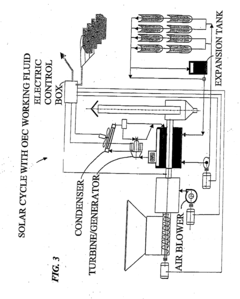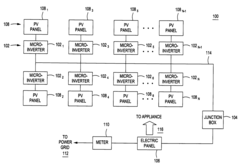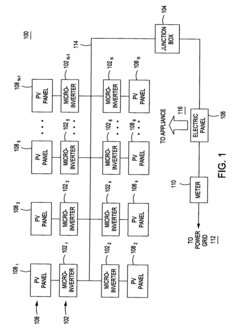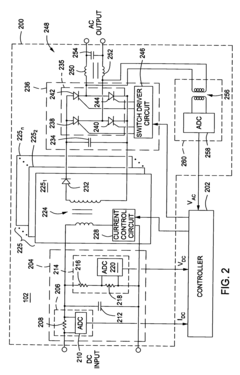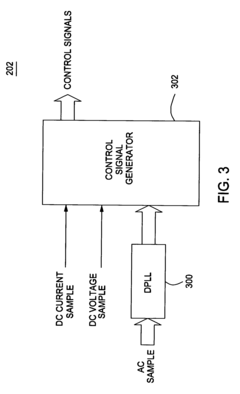How to Utilize Solar Inverters in Remote Locations?
JUL 17, 20259 MIN READ
Generate Your Research Report Instantly with AI Agent
Patsnap Eureka helps you evaluate technical feasibility & market potential.
Solar Inverter Evolution and Objectives
Solar inverter technology has undergone significant evolution since its inception in the 1990s. Initially designed for grid-tied systems in urban areas, these devices have transformed to meet the growing demand for off-grid and remote applications. The primary objective of solar inverters in remote locations is to efficiently convert DC power from solar panels into usable AC power, while ensuring system reliability and longevity in challenging environments.
The evolution of solar inverters for remote applications has been driven by several key factors. First, the need for increased efficiency in power conversion has led to the development of advanced Maximum Power Point Tracking (MPPT) algorithms. These algorithms optimize the power output of solar panels under varying environmental conditions, crucial for remote locations with inconsistent sunlight exposure.
Another significant advancement has been the integration of energy storage capabilities. Modern solar inverters often incorporate battery management systems, allowing for seamless integration with energy storage solutions. This feature is particularly vital in remote locations where grid connectivity is limited or non-existent, enabling continuous power supply even during periods of low solar generation.
Durability and resilience have also been key focus areas in the evolution of solar inverters for remote applications. Manufacturers have developed ruggedized designs capable of withstanding extreme temperatures, high humidity, and dust – common challenges in isolated environments. Additionally, remote monitoring and diagnostic capabilities have been integrated, allowing for proactive maintenance and reducing the need for on-site interventions.
The objectives for utilizing solar inverters in remote locations extend beyond mere power conversion. These devices aim to provide a reliable, sustainable, and cost-effective energy solution for areas with limited access to traditional power infrastructure. They play a crucial role in electrifying rural communities, powering telecommunications equipment in isolated areas, and supporting off-grid industrial operations.
Looking forward, the evolution of solar inverters for remote applications is expected to focus on further improving efficiency, enhancing integration with smart grid technologies, and expanding compatibility with diverse renewable energy sources. The development of more compact, lightweight designs will facilitate easier transportation and installation in hard-to-reach locations. Additionally, advancements in artificial intelligence and machine learning are anticipated to enhance predictive maintenance capabilities and optimize system performance in varying environmental conditions.
The evolution of solar inverters for remote applications has been driven by several key factors. First, the need for increased efficiency in power conversion has led to the development of advanced Maximum Power Point Tracking (MPPT) algorithms. These algorithms optimize the power output of solar panels under varying environmental conditions, crucial for remote locations with inconsistent sunlight exposure.
Another significant advancement has been the integration of energy storage capabilities. Modern solar inverters often incorporate battery management systems, allowing for seamless integration with energy storage solutions. This feature is particularly vital in remote locations where grid connectivity is limited or non-existent, enabling continuous power supply even during periods of low solar generation.
Durability and resilience have also been key focus areas in the evolution of solar inverters for remote applications. Manufacturers have developed ruggedized designs capable of withstanding extreme temperatures, high humidity, and dust – common challenges in isolated environments. Additionally, remote monitoring and diagnostic capabilities have been integrated, allowing for proactive maintenance and reducing the need for on-site interventions.
The objectives for utilizing solar inverters in remote locations extend beyond mere power conversion. These devices aim to provide a reliable, sustainable, and cost-effective energy solution for areas with limited access to traditional power infrastructure. They play a crucial role in electrifying rural communities, powering telecommunications equipment in isolated areas, and supporting off-grid industrial operations.
Looking forward, the evolution of solar inverters for remote applications is expected to focus on further improving efficiency, enhancing integration with smart grid technologies, and expanding compatibility with diverse renewable energy sources. The development of more compact, lightweight designs will facilitate easier transportation and installation in hard-to-reach locations. Additionally, advancements in artificial intelligence and machine learning are anticipated to enhance predictive maintenance capabilities and optimize system performance in varying environmental conditions.
Remote Area Energy Demand Analysis
Remote areas face unique energy challenges due to their geographical isolation and limited access to traditional power grids. The demand for reliable and sustainable energy solutions in these locations has been steadily increasing, driven by factors such as population growth, economic development, and the need for improved living standards. Solar inverters play a crucial role in addressing these energy needs by converting DC power generated from solar panels into usable AC power for various applications.
In remote areas, energy demand primarily stems from residential, commercial, and small-scale industrial activities. Residential energy consumption typically includes lighting, heating, cooling, and powering household appliances. Commercial energy needs often revolve around powering small businesses, schools, healthcare facilities, and community centers. Small-scale industrial activities, such as agricultural processing or local manufacturing, also contribute to the overall energy demand in these regions.
The energy demand pattern in remote locations often differs from urban areas due to the unique lifestyle and economic activities prevalent in these regions. For instance, there may be higher energy requirements during specific seasons for agricultural activities or during particular hours of the day for community gatherings. Understanding these patterns is crucial for designing effective solar inverter systems that can meet the fluctuating energy needs of remote communities.
One of the key challenges in remote area energy demand is the lack of reliable data and infrastructure for accurate measurement and forecasting. This makes it difficult to precisely quantify the energy requirements and plan for future growth. However, various studies and field observations have shown a general trend of increasing energy demand in remote areas, particularly in developing regions.
The integration of solar inverters in remote locations can significantly impact the energy landscape by providing a clean, renewable source of power. This technology can help bridge the energy gap in areas where grid extension is not economically viable or technically feasible. Solar inverters, when combined with energy storage solutions, can offer a more stable and consistent power supply, addressing the intermittent nature of solar energy generation.
To effectively utilize solar inverters in remote locations, it is essential to conduct a thorough analysis of the local energy demand profile. This includes assessing the peak load requirements, daily and seasonal variations in energy consumption, and potential future growth in demand. Such analysis helps in sizing the solar inverter systems appropriately and designing hybrid solutions that may incorporate other renewable energy sources or backup systems to ensure reliable power supply.
In remote areas, energy demand primarily stems from residential, commercial, and small-scale industrial activities. Residential energy consumption typically includes lighting, heating, cooling, and powering household appliances. Commercial energy needs often revolve around powering small businesses, schools, healthcare facilities, and community centers. Small-scale industrial activities, such as agricultural processing or local manufacturing, also contribute to the overall energy demand in these regions.
The energy demand pattern in remote locations often differs from urban areas due to the unique lifestyle and economic activities prevalent in these regions. For instance, there may be higher energy requirements during specific seasons for agricultural activities or during particular hours of the day for community gatherings. Understanding these patterns is crucial for designing effective solar inverter systems that can meet the fluctuating energy needs of remote communities.
One of the key challenges in remote area energy demand is the lack of reliable data and infrastructure for accurate measurement and forecasting. This makes it difficult to precisely quantify the energy requirements and plan for future growth. However, various studies and field observations have shown a general trend of increasing energy demand in remote areas, particularly in developing regions.
The integration of solar inverters in remote locations can significantly impact the energy landscape by providing a clean, renewable source of power. This technology can help bridge the energy gap in areas where grid extension is not economically viable or technically feasible. Solar inverters, when combined with energy storage solutions, can offer a more stable and consistent power supply, addressing the intermittent nature of solar energy generation.
To effectively utilize solar inverters in remote locations, it is essential to conduct a thorough analysis of the local energy demand profile. This includes assessing the peak load requirements, daily and seasonal variations in energy consumption, and potential future growth in demand. Such analysis helps in sizing the solar inverter systems appropriately and designing hybrid solutions that may incorporate other renewable energy sources or backup systems to ensure reliable power supply.
Solar Inverter Challenges in Isolated Environments
Solar inverters face unique challenges when deployed in remote locations, primarily due to the harsh environmental conditions and limited access to resources. These isolated environments often experience extreme temperatures, high humidity, dust, and corrosive atmospheres, which can significantly impact the performance and longevity of solar inverters.
One of the primary challenges is the lack of reliable grid infrastructure in remote areas. Solar inverters must be designed to operate efficiently in off-grid or weak-grid scenarios, requiring advanced energy management capabilities and robust storage solutions. This necessitates the integration of smart control systems and energy storage technologies to ensure a stable power supply despite intermittent solar generation.
Maintenance and repair pose significant hurdles in isolated locations. The limited availability of skilled technicians and replacement parts can lead to extended downtime in case of equipment failure. Consequently, solar inverters deployed in these environments must prioritize reliability, durability, and ease of maintenance to minimize the need for on-site interventions.
Communication and monitoring present another set of challenges. Remote locations often lack reliable internet connectivity, making it difficult to implement real-time monitoring and control systems. This limitation hampers the ability to detect and address issues promptly, potentially leading to reduced system efficiency and increased downtime.
The harsh environmental conditions in remote areas can accelerate component degradation. Solar inverters must be designed with enhanced thermal management systems, corrosion-resistant materials, and robust enclosures to withstand extreme temperatures, humidity, and dust. Additionally, protection against wildlife intrusion and vandalism is crucial in these isolated settings.
Power quality and stability are critical concerns in remote applications. Solar inverters must maintain consistent voltage and frequency output despite fluctuations in solar irradiance and varying load demands. This requires advanced control algorithms and fast-response capabilities to ensure seamless power delivery and protect sensitive equipment.
Energy storage integration is essential for remote solar installations. Inverters must be compatible with various battery technologies and incorporate sophisticated charge controllers to optimize battery life and system performance. The ability to manage hybrid systems, combining solar with other renewable or conventional energy sources, is increasingly important in isolated environments.
Scalability and modularity are key considerations for solar inverters in remote locations. As energy demands grow or change over time, the ability to easily expand or reconfigure the system without significant infrastructure changes is crucial. This flexibility helps to future-proof installations and reduce long-term costs.
Addressing these challenges requires innovative design approaches, advanced materials, and intelligent control systems. Manufacturers must focus on developing ruggedized, high-efficiency inverters specifically tailored for remote applications, incorporating features such as self-diagnostic capabilities, redundant components, and adaptive control algorithms to enhance reliability and performance in isolated environments.
One of the primary challenges is the lack of reliable grid infrastructure in remote areas. Solar inverters must be designed to operate efficiently in off-grid or weak-grid scenarios, requiring advanced energy management capabilities and robust storage solutions. This necessitates the integration of smart control systems and energy storage technologies to ensure a stable power supply despite intermittent solar generation.
Maintenance and repair pose significant hurdles in isolated locations. The limited availability of skilled technicians and replacement parts can lead to extended downtime in case of equipment failure. Consequently, solar inverters deployed in these environments must prioritize reliability, durability, and ease of maintenance to minimize the need for on-site interventions.
Communication and monitoring present another set of challenges. Remote locations often lack reliable internet connectivity, making it difficult to implement real-time monitoring and control systems. This limitation hampers the ability to detect and address issues promptly, potentially leading to reduced system efficiency and increased downtime.
The harsh environmental conditions in remote areas can accelerate component degradation. Solar inverters must be designed with enhanced thermal management systems, corrosion-resistant materials, and robust enclosures to withstand extreme temperatures, humidity, and dust. Additionally, protection against wildlife intrusion and vandalism is crucial in these isolated settings.
Power quality and stability are critical concerns in remote applications. Solar inverters must maintain consistent voltage and frequency output despite fluctuations in solar irradiance and varying load demands. This requires advanced control algorithms and fast-response capabilities to ensure seamless power delivery and protect sensitive equipment.
Energy storage integration is essential for remote solar installations. Inverters must be compatible with various battery technologies and incorporate sophisticated charge controllers to optimize battery life and system performance. The ability to manage hybrid systems, combining solar with other renewable or conventional energy sources, is increasingly important in isolated environments.
Scalability and modularity are key considerations for solar inverters in remote locations. As energy demands grow or change over time, the ability to easily expand or reconfigure the system without significant infrastructure changes is crucial. This flexibility helps to future-proof installations and reduce long-term costs.
Addressing these challenges requires innovative design approaches, advanced materials, and intelligent control systems. Manufacturers must focus on developing ruggedized, high-efficiency inverters specifically tailored for remote applications, incorporating features such as self-diagnostic capabilities, redundant components, and adaptive control algorithms to enhance reliability and performance in isolated environments.
Current Remote Solar Inverter Solutions
01 Grid-tied solar inverter systems
Grid-tied solar inverter systems are designed to connect photovoltaic arrays to the utility grid. These systems typically include features for maximum power point tracking, DC-to-AC conversion, and grid synchronization. They often incorporate safety mechanisms such as anti-islanding protection and may support bidirectional power flow for energy storage integration.- Grid-tied solar inverter systems: Grid-tied solar inverter systems are designed to connect solar panels to the utility grid. These systems convert DC power from solar panels into AC power compatible with the grid, allowing for bidirectional power flow. They often include features like maximum power point tracking (MPPT) and anti-islanding protection for efficient and safe operation.
- Microinverter technology: Microinverters are small inverters attached to individual solar panels or small groups of panels. They convert DC to AC at the panel level, offering advantages such as improved efficiency, easier system scalability, and enhanced monitoring capabilities. Microinverters can also mitigate the effects of partial shading on overall system performance.
- Power optimization and management: Solar inverters incorporate various power optimization and management techniques to maximize energy yield and system efficiency. These may include advanced MPPT algorithms, reactive power control, and intelligent power management systems that can adapt to changing environmental conditions and grid requirements.
- Safety and protection features: Solar inverters integrate multiple safety and protection features to ensure reliable operation and prevent damage to the system or harm to users. These features may include ground fault detection, surge protection, over/under voltage protection, and thermal management systems. Advanced inverters also incorporate smart grid functionalities for grid stability and support.
- Energy storage integration: Modern solar inverters are increasingly designed to integrate with energy storage systems, such as batteries. These hybrid inverters can manage power flow between solar panels, batteries, and the grid, enabling features like self-consumption optimization, backup power during outages, and participation in grid services.
02 Microinverter technology
Microinverters are small inverters attached to individual solar panels or small groups of panels. They convert DC to AC at the panel level, offering advantages such as improved system efficiency, easier installation, and enhanced monitoring capabilities. Microinverters can also mitigate the effects of partial shading and panel mismatch.Expand Specific Solutions03 Power optimization and monitoring
Solar inverters often incorporate advanced power optimization techniques and monitoring systems. These features may include real-time performance tracking, remote diagnostics, and predictive maintenance capabilities. Some inverters use machine learning algorithms to optimize power output based on historical data and environmental conditions.Expand Specific Solutions04 Multi-level and modular inverter designs
Multi-level and modular inverter designs aim to improve efficiency, reduce harmonics, and enhance reliability. These architectures can include cascaded H-bridge topologies, neutral point clamped designs, or modular multi-level converters. Such designs often offer benefits like scalability, fault tolerance, and improved power quality.Expand Specific Solutions05 Hybrid and battery-integrated inverters
Hybrid and battery-integrated inverters combine traditional solar inverter functionality with energy storage capabilities. These systems can manage power flow between the PV array, battery, and grid, enabling features like self-consumption optimization, backup power, and grid support services. They often include sophisticated energy management systems and can operate in both grid-connected and off-grid modes.Expand Specific Solutions
Key Solar Inverter Manufacturers and Providers
The solar inverter market for remote locations is in a growth phase, driven by increasing demand for off-grid and microgrid solutions. The global market size is expanding, with projections indicating significant growth in the coming years. Technologically, solar inverters for remote applications are advancing rapidly, with key players like Enphase Energy, SMA Solar Technology, and SolarEdge Technologies leading innovation. These companies are developing more efficient, reliable, and smart inverter solutions tailored for challenging remote environments. Emerging players such as Guangzhou Goaland Energy Conservation Tech and Qingdao Aositaike Solar Energy Technology are also contributing to the competitive landscape, particularly in the Asian market.
Enphase Energy, Inc.
Technical Solution: Enphase Energy specializes in microinverter technology, which is particularly well-suited for remote solar installations. Their microinverters are installed on each individual solar panel, converting DC to AC at the panel level. This approach offers several advantages for remote locations, including increased system reliability as the failure of one microinverter doesn't affect the entire system[1]. Enphase's IQ series microinverters are designed with simplified wiring and are highly compact, reducing installation complexity in hard-to-reach areas[2]. The company has also developed the Enphase Envoy, a communication gateway that enables remote monitoring and management of the solar system. This is crucial for maintaining system performance in remote locations without frequent on-site visits[3]. Additionally, Enphase's microinverters are engineered to withstand harsh environmental conditions, with a NEMA 6 enclosure rating for water resistance and durability in extreme temperatures.
Strengths: High reliability due to distributed architecture, ease of installation, and robust remote monitoring capabilities. Weaknesses: Potentially higher upfront costs compared to string inverter systems, and increased number of components that could require maintenance.
SMA Solar Technology AG
Technical Solution: SMA Solar Technology AG has developed advanced solar inverter solutions for remote locations, focusing on their Sunny Island battery inverter series. These inverters are designed to create off-grid and hybrid systems, enabling the integration of renewable energy sources in areas without reliable grid access. The Sunny Island inverters can manage complex micro-grids, balancing power generation from solar panels, wind turbines, and diesel generators with energy storage in batteries[1]. They utilize intelligent load and energy management to optimize system efficiency and extend battery life. SMA's inverters also feature robust design for harsh environments, with high protection classes (up to IP54) to withstand dust and water ingress[2]. Additionally, SMA has implemented remote monitoring and control capabilities through their Sunny Portal, allowing for efficient maintenance and operation of solar systems in remote areas[3].
Strengths: Robust design for harsh environments, advanced energy management capabilities, and remote monitoring features. Weaknesses: Higher initial cost compared to simpler inverters, and potential complexity in setup and maintenance for non-technical users in remote areas.
Innovative Solar Inverter Technologies for Remote Use
Method of and apparatus for producing power in remote locations
PatentInactiveUS20040060293A1
Innovation
- A closed cycle vapor turbine unit based on an organic Rankine cycle that combines biomass and solar energy, using a biomass furnace for nighttime or low-solar periods and solar parabolic concentrating systems for heat, with a controller managing fuel supply based on energy demand and evaporator temperature.
Method and apparatus for converting direct current to alternating current
PatentActiveUS20110012429A1
Innovation
- A micro-inverter system with multiple power stages and a controller that dynamically selects the appropriate power stages and operational modes based on DC input power, switching between flyback, interleaved flyback, and quasi-resonant modes to optimize conversion efficiency, ensuring maximum power point tracking and phase synchronicity with the grid.
Environmental Impact of Remote Solar Installations
The implementation of solar inverters in remote locations presents both opportunities and challenges for environmental conservation. While these installations contribute to the reduction of carbon emissions by harnessing renewable energy, their impact on local ecosystems must be carefully considered.
Remote solar installations often require land clearing for panel placement and infrastructure development. This process can lead to habitat fragmentation and loss of biodiversity, particularly in sensitive ecosystems. The extent of this impact varies depending on the location and scale of the installation. In arid regions, where vegetation is sparse, the environmental footprint may be less significant. However, in more biodiverse areas, careful site selection and mitigation strategies are crucial.
The production and transportation of solar inverters and associated equipment to remote locations also contribute to the overall environmental impact. Manufacturing processes involve the extraction of raw materials and energy consumption, while transportation to isolated areas often relies on fossil fuel-powered vehicles. These factors must be weighed against the long-term environmental benefits of clean energy generation.
Water usage is another environmental consideration in remote solar installations. Some solar technologies require water for cooling or cleaning, which can strain local water resources, especially in arid regions. Innovative dry-cleaning techniques and water-efficient cooling systems are being developed to address this issue.
Noise pollution from inverters and other equipment can affect local wildlife, particularly in previously undisturbed areas. Modern inverter designs are increasingly focusing on noise reduction to minimize this impact. Additionally, electromagnetic fields generated by inverters and power lines may influence animal behavior and migration patterns, though research in this area is ongoing.
End-of-life considerations for solar inverters in remote locations pose unique challenges. Proper disposal or recycling of equipment can be logistically difficult and costly in isolated areas. Developing efficient recycling processes and implementing take-back programs are essential to mitigate the long-term environmental impact of these installations.
Despite these challenges, remote solar installations offer significant environmental benefits. They reduce reliance on diesel generators, which are commonly used in remote areas and contribute to air pollution and greenhouse gas emissions. Solar power also enables the electrification of remote communities without the need for extensive power grid infrastructure, potentially reducing the overall environmental footprint of energy distribution.
In conclusion, while remote solar installations utilizing inverters present some environmental challenges, their net positive impact on reducing carbon emissions and providing clean energy to isolated areas is substantial. Careful planning, site selection, and ongoing research into more environmentally friendly technologies can help maximize the benefits while minimizing the ecological impact of these crucial renewable energy projects.
Remote solar installations often require land clearing for panel placement and infrastructure development. This process can lead to habitat fragmentation and loss of biodiversity, particularly in sensitive ecosystems. The extent of this impact varies depending on the location and scale of the installation. In arid regions, where vegetation is sparse, the environmental footprint may be less significant. However, in more biodiverse areas, careful site selection and mitigation strategies are crucial.
The production and transportation of solar inverters and associated equipment to remote locations also contribute to the overall environmental impact. Manufacturing processes involve the extraction of raw materials and energy consumption, while transportation to isolated areas often relies on fossil fuel-powered vehicles. These factors must be weighed against the long-term environmental benefits of clean energy generation.
Water usage is another environmental consideration in remote solar installations. Some solar technologies require water for cooling or cleaning, which can strain local water resources, especially in arid regions. Innovative dry-cleaning techniques and water-efficient cooling systems are being developed to address this issue.
Noise pollution from inverters and other equipment can affect local wildlife, particularly in previously undisturbed areas. Modern inverter designs are increasingly focusing on noise reduction to minimize this impact. Additionally, electromagnetic fields generated by inverters and power lines may influence animal behavior and migration patterns, though research in this area is ongoing.
End-of-life considerations for solar inverters in remote locations pose unique challenges. Proper disposal or recycling of equipment can be logistically difficult and costly in isolated areas. Developing efficient recycling processes and implementing take-back programs are essential to mitigate the long-term environmental impact of these installations.
Despite these challenges, remote solar installations offer significant environmental benefits. They reduce reliance on diesel generators, which are commonly used in remote areas and contribute to air pollution and greenhouse gas emissions. Solar power also enables the electrification of remote communities without the need for extensive power grid infrastructure, potentially reducing the overall environmental footprint of energy distribution.
In conclusion, while remote solar installations utilizing inverters present some environmental challenges, their net positive impact on reducing carbon emissions and providing clean energy to isolated areas is substantial. Careful planning, site selection, and ongoing research into more environmentally friendly technologies can help maximize the benefits while minimizing the ecological impact of these crucial renewable energy projects.
Regulatory Framework for Off-Grid Solar Systems
The regulatory framework for off-grid solar systems plays a crucial role in the deployment and utilization of solar inverters in remote locations. These regulations are designed to ensure safety, reliability, and environmental sustainability while promoting the adoption of renewable energy solutions in areas with limited or no access to the main power grid.
In many countries, off-grid solar systems are subject to specific regulations that govern their installation, operation, and maintenance. These regulations often cover aspects such as system sizing, component quality standards, electrical safety requirements, and environmental impact assessments. For instance, some jurisdictions mandate the use of certified solar inverters that meet specific efficiency and safety standards to ensure optimal performance and minimize risks.
Permitting processes for off-grid solar installations vary widely across different regions. Some areas have streamlined procedures to encourage the adoption of renewable energy, while others may require more extensive documentation and approvals. This can include obtaining electrical permits, building permits, and environmental clearances, depending on the scale and location of the installation.
Many regulatory frameworks also address the issue of grid integration for off-grid solar systems. This is particularly relevant for remote locations that may eventually be connected to the main grid. Regulations may specify requirements for inverters to be grid-compatible, allowing for seamless integration when grid expansion occurs. Additionally, some jurisdictions have implemented net metering policies for off-grid systems, enabling excess energy to be fed back into the grid when connection becomes available.
Environmental regulations are another critical aspect of the regulatory framework for off-grid solar systems. These may include guidelines for proper disposal of solar panels and batteries at the end of their lifecycle, as well as restrictions on land use in environmentally sensitive areas. Some regions also require environmental impact assessments for larger off-grid installations to ensure minimal disruption to local ecosystems.
Financial incentives and support mechanisms are often incorporated into the regulatory framework to promote the adoption of off-grid solar systems in remote locations. These can include tax credits, grants, or subsidies for equipment purchases and installation costs. Some governments have also implemented renewable energy targets specifically for off-grid areas, driving policy support for solar inverter deployment in remote locations.
As the technology and market for off-grid solar systems continue to evolve, regulatory frameworks are also adapting. Many jurisdictions are working to balance the need for safety and quality standards with the goal of reducing barriers to entry for off-grid solar solutions. This includes efforts to harmonize standards across regions, simplify permitting processes, and provide clear guidelines for system installers and operators.
In many countries, off-grid solar systems are subject to specific regulations that govern their installation, operation, and maintenance. These regulations often cover aspects such as system sizing, component quality standards, electrical safety requirements, and environmental impact assessments. For instance, some jurisdictions mandate the use of certified solar inverters that meet specific efficiency and safety standards to ensure optimal performance and minimize risks.
Permitting processes for off-grid solar installations vary widely across different regions. Some areas have streamlined procedures to encourage the adoption of renewable energy, while others may require more extensive documentation and approvals. This can include obtaining electrical permits, building permits, and environmental clearances, depending on the scale and location of the installation.
Many regulatory frameworks also address the issue of grid integration for off-grid solar systems. This is particularly relevant for remote locations that may eventually be connected to the main grid. Regulations may specify requirements for inverters to be grid-compatible, allowing for seamless integration when grid expansion occurs. Additionally, some jurisdictions have implemented net metering policies for off-grid systems, enabling excess energy to be fed back into the grid when connection becomes available.
Environmental regulations are another critical aspect of the regulatory framework for off-grid solar systems. These may include guidelines for proper disposal of solar panels and batteries at the end of their lifecycle, as well as restrictions on land use in environmentally sensitive areas. Some regions also require environmental impact assessments for larger off-grid installations to ensure minimal disruption to local ecosystems.
Financial incentives and support mechanisms are often incorporated into the regulatory framework to promote the adoption of off-grid solar systems in remote locations. These can include tax credits, grants, or subsidies for equipment purchases and installation costs. Some governments have also implemented renewable energy targets specifically for off-grid areas, driving policy support for solar inverter deployment in remote locations.
As the technology and market for off-grid solar systems continue to evolve, regulatory frameworks are also adapting. Many jurisdictions are working to balance the need for safety and quality standards with the goal of reducing barriers to entry for off-grid solar solutions. This includes efforts to harmonize standards across regions, simplify permitting processes, and provide clear guidelines for system installers and operators.
Unlock deeper insights with Patsnap Eureka Quick Research — get a full tech report to explore trends and direct your research. Try now!
Generate Your Research Report Instantly with AI Agent
Supercharge your innovation with Patsnap Eureka AI Agent Platform!
